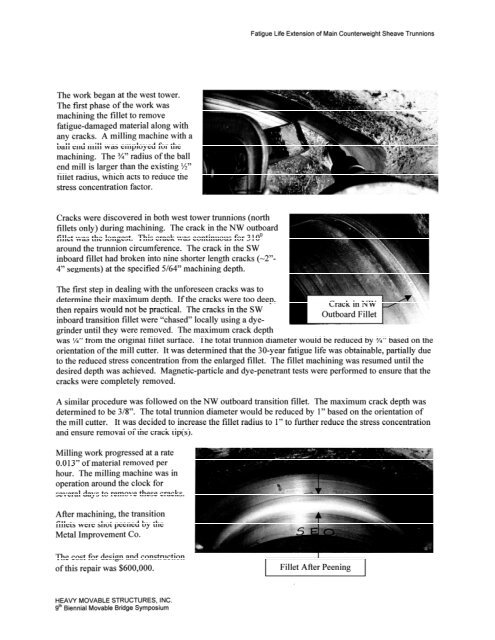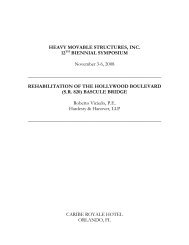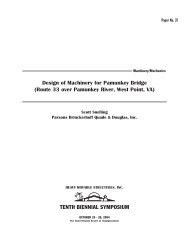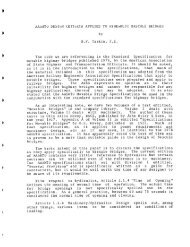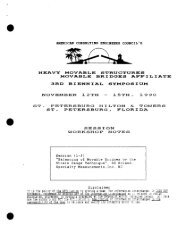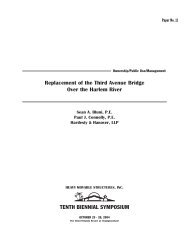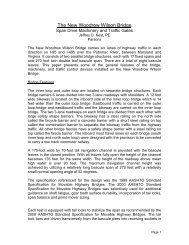Fatigue of Counterweight Sheave Trunnions - Heavy Movable ...
Fatigue of Counterweight Sheave Trunnions - Heavy Movable ...
Fatigue of Counterweight Sheave Trunnions - Heavy Movable ...
You also want an ePaper? Increase the reach of your titles
YUMPU automatically turns print PDFs into web optimized ePapers that Google loves.
The u.ork began at the west tower.<br />
The first phase <strong>of</strong> the work was<br />
machining the fillet to remove<br />
fatigue-damaged material along with<br />
any cracks. A milling machine with a<br />
ball end mill was employed for the<br />
niachining. The XI'' radius <strong>of</strong> the ball<br />
end niill is larger than the existing %"<br />
fillet radius, which acts to reduce the<br />
stress concentration factor.<br />
Cracks were discovered in both west tower trunnions (north<br />
fillets only) during machining. The crack in the NW outboard<br />
fillet was the longest. This crack was continuous for 31 0'<br />
around the trunnion circumference. The crack in the SW<br />
inboard fillet had broken into nine shorter length cracks (-2"-<br />
4" segments) at the specified 5/64" machining depth.<br />
<strong>Fatigue</strong> Life Extension <strong>of</strong> Main Countetweight <strong>Sheave</strong> <strong>Trunnions</strong><br />
The first step in dealing with the unforeseen cracks was to<br />
determine their maximum depth. If the cracks were too deep,<br />
then repairs would not be practical. The cracks in the SW<br />
inboard transition fillet were "chased" locally using a dye-<br />
grinder until they were removed. The maximum crack depth<br />
was W' from the original fillet surface. The total trunnion diameter would be reduced by %" based on the<br />
orientation <strong>of</strong> the mill cutter. It was determined that the 30-year fatigue life was obtainable, partially due<br />
to the reduced stress concentration from the enlarged fillet. The fillet machining was resumed until the<br />
desired depth was achieved. Magnetic-particle and dye-penetrant tests were performed to ensure that the<br />
cracks were completely removed.<br />
A similar procedure was followed on the NW outboard transition fillet. The maximum crack depth was<br />
determined to be 318". The total trunnion diameter would be reduced by 1'' based on the orientation <strong>of</strong><br />
the mill cutter. It was decided to increase the fillet radius to 1" to hrther reduce the stress concentration<br />
and ensure removal <strong>of</strong> the crack tip(s).<br />
Milling work progressed at a rate<br />
0.0 13.' <strong>of</strong> material removed per<br />
hoiir. 'file milling machine was in<br />
operation around the clock for<br />
several days to remove these cracks.<br />
After ~nachining, the transition<br />
fillets were shot pecncd by the<br />
Metal Improvement Co.<br />
'lhe cost for design and construction<br />
<strong>of</strong> this repair was $600,000.<br />
HEAVY MOVABLE STRUCTURES, INC.<br />
91h ~iennial <strong>Movable</strong> Bridge Symposium


